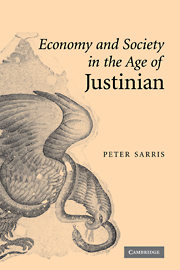Book contents
- Frontmatter
- Contents
- List of figures
- Preface
- Introduction
- 1 Egypt and the political economy of empire
- 2 The Apion archive: economic structure and estate accounts
- 3 Labour and administration: the evidence of the contractual papyri
- 4 Letters and petitions: social relations in the sixth-century Oxyrhynchite
- 5 The Apiones and their analogues
- 6 On the margins of magnate power: Dioscorus and Aphrodito
- 7 Landscapes of power: the great estate beyond Egypt
- 8 The historiography of the great estate
- 9 The great estate and the imperial authorities
- 10 The rise of the great estate
- 11 Economy and society in the age of Justinian
- Conclusion
- Bibliography
- Index
Preface
Published online by Cambridge University Press: 24 July 2009
- Frontmatter
- Contents
- List of figures
- Preface
- Introduction
- 1 Egypt and the political economy of empire
- 2 The Apion archive: economic structure and estate accounts
- 3 Labour and administration: the evidence of the contractual papyri
- 4 Letters and petitions: social relations in the sixth-century Oxyrhynchite
- 5 The Apiones and their analogues
- 6 On the margins of magnate power: Dioscorus and Aphrodito
- 7 Landscapes of power: the great estate beyond Egypt
- 8 The historiography of the great estate
- 9 The great estate and the imperial authorities
- 10 The rise of the great estate
- 11 Economy and society in the age of Justinian
- Conclusion
- Bibliography
- Index
Summary
This work is meant as a short contribution to the study of the political economy of the Eastern Roman Empire in the age of the Emperor Justinian, one of the most extraordinary yet enigmatic rulers to have reigned in Byzantine Constantinople. For reasons that will be explained in the Introduction, however, much of it is concerned with the history of late Roman Egypt. The modern historiography of Egypt from the fourth to the seventh centuries ad is an important topic, which, for reasons of argumentative structure, will not be addressed in detail until chapter eight. It is perhaps worth signalling at the outset, however, for the benefit of those familiar with the topic, where my approach and conclusions stand in relation to the broader field. First, I am largely in agreement with Banaji in regarding the great estates of late Roman Egypt as highly commercialised, monetised, and sophisticated economic enterprises, although I place more emphasis than he does on the role played by coercion in the expansion and maintenance of these estates. I am also unconvinced by readings of the sources that present these great estates as ‘semi-public institutions’, or that are inclined to emphasise co-operative, symbiotic relations between the owners of these estates and the imperial authorities. For most of the period in question, the state only accommodated the interests of great landowners because it had to, and it invariably emerged weaker as a result.
- Type
- Chapter
- Information
- Economy and Society in the Age of Justinian , pp. vii - xiiPublisher: Cambridge University PressPrint publication year: 2006

